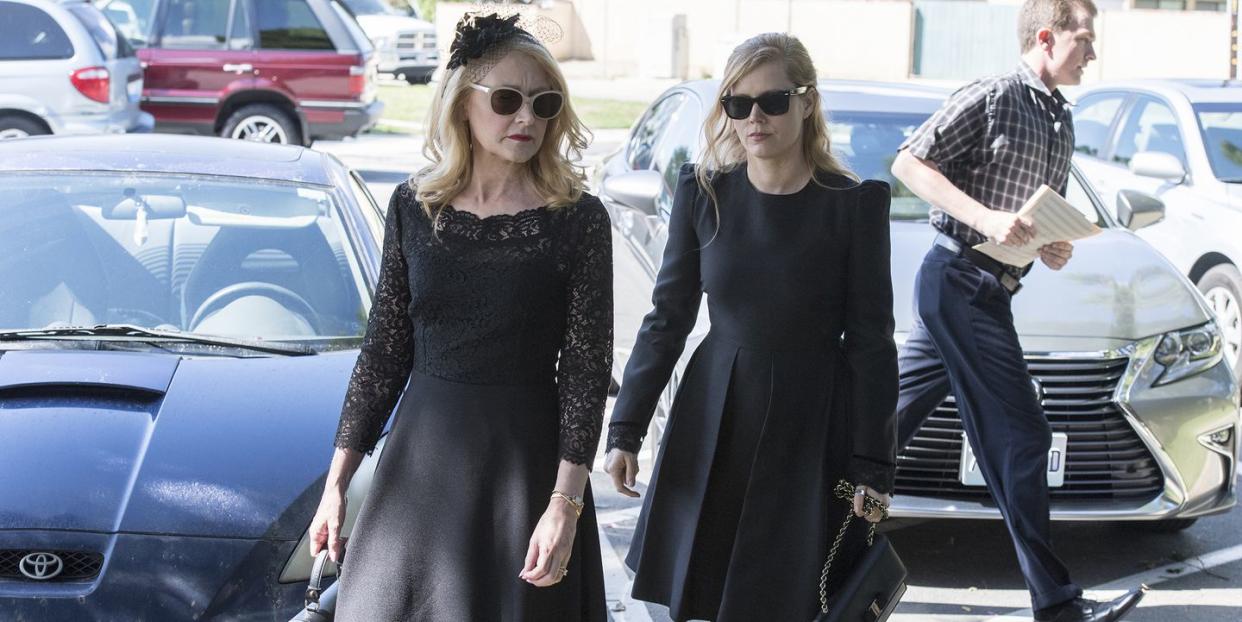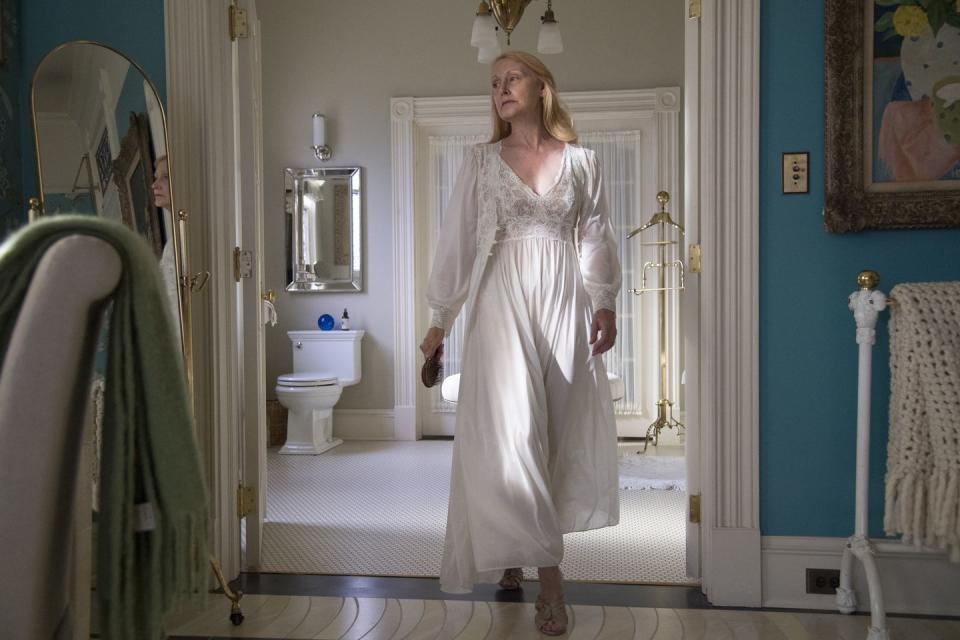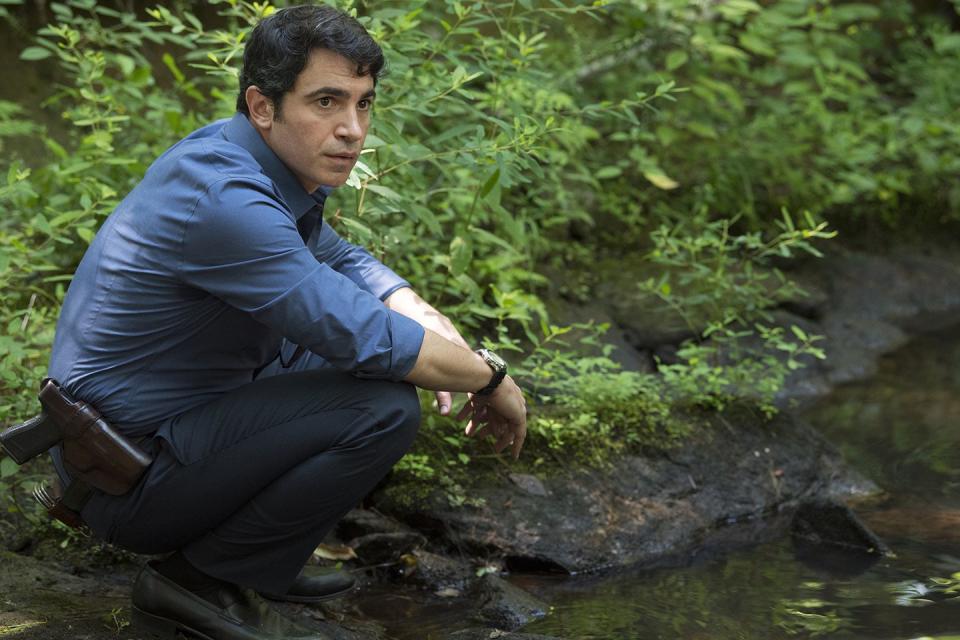Appearances Are Everything in 'Sharp Objects' Episode 2

Spoilers for Episode 2 of Sharp Objects below.
The revelation of Camille’s scars at the end of Sharp Objects’ premiere episode was a striking and bold image, introducing a raw subject that TV rarely touches. Self-harm never has a simple explanation, but in many cases, sufferers express a desire to have their internal pain made manifest.
“The reason I wrote about the scars, about Camille writing on her skin, was because I felt that [misery] of ‘Why can’t anyone see how much pain I’m in?’” author Gillian Flynn told The Hollywood Reporter of her depiction of Camille’s self-harm in the novel. “I wished I could bear witness somehow. I had these fantasies of being mangled-of showing how much pain I was in.” In this week's episode, "Dirt," it becomes clear why Camille feels the urge to etch her pain directly onto her skin-she comes from a family where appearances are everything, while anything ugly is repressed and silenced, painted over until it looks pretty.
That goes for a lot of families in Wind Gap. During the gathering following Natalie Keene’s funeral, Camille sneaks up to her room and finds it decorated in bright pink; still a little girl’s bedroom, like something out of a dollhouse. But Natalie herself was an outdoorsy tomboy, who frequently came home in dirty clothes and kept a pet tarantula in a jar. This schism-Mama’s Little Girl versus a real adolescent-is mirrored in Amma, who’s dressed up like a doll by Adora but is almost unrecognizable when Camille runs into her at the gas station, all Daisy Dukes and roller skates, buying liquor on the sly with her friends. “I’ve been playing that game for twenty years,” Camille says casually, doing nothing to intervene as Amma swaps out Sprite for vodka. Incorrigible girls, all three.

Though Camille’s now a grown woman, her mother is still trying to curate her and smooth off her rough edges-while showing no interest at all in her daughter’s actual problems. Adora is trying to dress Camille up both literally and figuratively here, lending her an ill-fitting dress for the funeral that ends up ripping a seam midway through the service; the drugstore sewing kit Camille buys to fix the hole ends up playing a more significant and ugly purpose later in the episode. And there’s an uncomfortable echo of Adora during Willis’ conversation with Chief Vickery, where he says that the killer posed Natalie’s body “like a prop, or a doll.”
Adora’s suffocating attention, her determination to keep everything pretty and sanitized and “nice,” has clearly taken a toll on both Camille and Amma, whose sudden screaming jag in the last scenes of the episode goes disturbingly unexplained. We’re seeing Amma only in scattershot glimpses-the picture-perfect princess, the rebellious teenager, the screaming child-and it’s not yet clear which parts are genuine and which are a facade she’s developed by necessity to survive in this family. In the aftermath of Amma's meltdown, the parallel between Natalie and Camille is spoken aloud, as Adora admits that Natalie’s wild, forest-roaming side reminded her of Camille. She adds, “I thought maybe I could help her, since clearly I couldn’t help you.” In a truly unsettling moment, Amma then tearfully asks, “I think Camille can be good. Can’t you, Camille?” as she and Adora both stare, reinforcing the suffocating pressure at the core of this family. Just be good. Don’t make a mess. Keep things nice.

And so back in her room, Camille falls back into old coping mechanisms, using the needle from that drugstore sewing kit to scratch cuts into her clothed leg and, later, her bare stomach, making physical the pain she’s never been allowed to speak out loud in this house. Wind Gap is already taking a psychological toll on her-she’s having mild hallucinations, first imagining a little girl in the corner of her bedroom, and later at the Keanes' house, she hears malicious whispers as she enters the room. The natural assumption in a murder mystery show is that the protagonist will gradually unravel clues until they discover the truth, but Camille’s grip on the truth seems to be loosening, rather than the other way around.
Key clues:
John Keene, Natalie’s brother, is a suspect in her murder. It’s not immediately clear why, but Camille’s gossipy former schoolmates offer up some handy exposition at the funeral. In brief, John’s just a little off. He’s been “crying up a storm”-too much to be quite genuine, in their opinion. One of the women seems to even be implying that there was something untoward in John’s feelings for his sister; “When siblings have unnatural affections… it leads into other things.” Yikes! For her part, Camille seems interested in John but not necessarily suspicious of him; she calls him “not the typical Wind Gap fare,” which, coming from her, can only be a compliment.
Bob Nash (Ann’s slightly creepy father who was grateful she got murdered instead of raped) is the cops’ other suspect: he says he was driving at the time of the murder, but can’t prove it. Ditto John.
During an exchange with Detective Willis, Camille sheds some superficial light on the layers of artifice at work in Wind Gap, explaining that when somebody here says “Bless your heart,” they really mean “Fuck you.” In exchange for her local knowledge, Willis shares some off-the-record info about his own investigation into the murders. Having been told by the coroner that Natalie’s teeth were removed with pliers, Willis bought himself a pig’s head and experimented with pulling out its teeth, to see how much strength such a thing would take. Willis is-to quote Camille-a sick fuck, and she’s into it. Given Camille’s slippery approach to journalistic ethics, sleeping with a source isn’t likely to pose much of an obstacle; she’s already openly lying to her editor, claiming that Natalie’s mother gave her a tour of the bedroom when in fact she didn’t have permission to be there.

Willis is trying to figure out why the killer’s MO changed so dramatically from murder to murder: Ann Nash’s body was left at the crime scene, while Natalie was posed in the center of town. Though Chief Vickery is dismissive of him so far, you can sense a begrudging respect forming here. The Grizzled Old Timer and Cocky Rookie is a pretty classic buddy cop trope, but given the tone of Sharp Objects that’s probably not quite where Willis and Vickery are headed.
Camille finds out that a boy named James Capisi supposedly witnessed Natalie's kidnapping, and according to his account, it was “The Woman in White”-a folkloric figure in town-who took her. When Camille finds James and asks him about the incident (again, worryingly unconcerned by journalistic ethics re: interviewing minors!), he isn’t eager to talk, but insists that the Woman in White “ain’t no ghost. It was real.” But Vickery dismisses this story when Camille asks why James isn’t being taken seriously as a witness; apparently, he’s known for telling tall tales at school.
The most unsettling thing about James besides his story: he’s holding a gun while talking to Camille. His mother, who is both a cancer patient and a meth addict, doesn’t seem particularly concerned by this when Camille alerts her, though it later transpires that she did call the cops. She wears a white hospital gown, and the police chief attributes James’s "Woman in White" story to this.
More significantly, though, Vickery dismisses the idea that a woman could possibly have committed the murders. “Trust me, it’s a man did this” he tells Camille, without providing any particularly compelling evidence for this. Willis thinks it’s a man too, on the basis of how much strength it took for him to yank out that pig’s teeth. So is James’s story a red herring?
If you or someone you know is struggling with self-harm or substance abuse, call the Substance Abuse and Mental Health Services Administration (SAMHSA) at 1-800-662-HELP (4357).
You Might Also Like